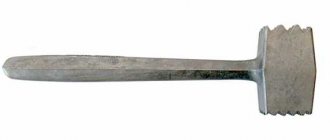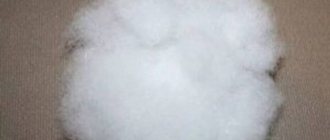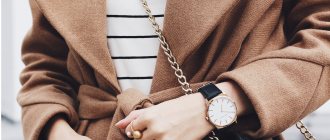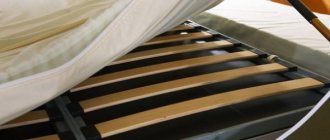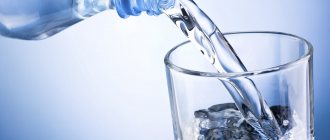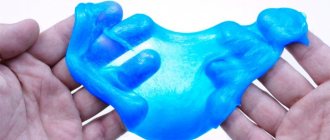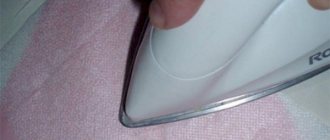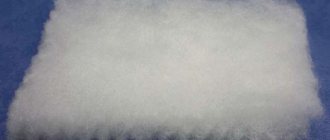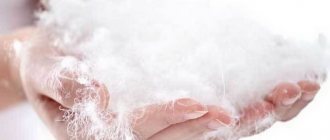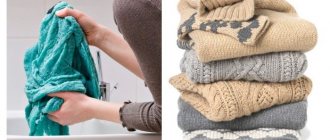Non-woven fabric is an extremely popular and sought-after type of material in modern sewing production. Due to its unusual properties, it is used as a lining for many fabric products. As a result of its use, the strength and wear resistance of the finished product increases, and deformation of individual parts is prevented. In addition, non-woven fabric helps to realize difficult design ideas. It is difficult to do without such material in many production processes: sewing outerwear, thin summer models, and other products.
Non-woven fabric is part of a group of paper-like cushioning materials made from cellulose fibers with the addition of polyester Source protkani.com
How to work with the material
When working with non-woven fabric, you need to adhere to some rules:
- Despite the cellulose origin of the fibers, interlining needs to be cut along the grain thread. Otherwise, the material may stretch and lose its shape after gluing.
- Before use, you need to correctly set the temperature and power of the iron. It must be selected taking into account the most sensitive of the materials used.
- The lining can only be ironed using an ironing iron - a thin cotton napkin of a neutral color. In its absence, both the fabric and the surface of the instrument may deteriorate.
- During the gluing process, the iron must be periodically moved from one section of the canvas to another, and not moved over its entire surface. Otherwise, the glue on the non-woven fabric may overheat, which will lead to the appearance of bubbles and distortions, which can lead to stretching and deformation of the material.
- You can glue the non-woven fabric in a dry mode or through a damp ironing iron. You should not spray it with water like dublerin.
- After finishing the work, the fabric should be laid out on the table and left for 20-30 minutes so that the glue completely hardens. Otherwise, the lining may peel off or become deformed.
Non-woven fabric when sewing.
Bonding to fabric
Step-by-step instructions for ironing interlining to a fabric base:
Cut out a part of the required shape and size from the main and backup material. Leave a 2-3 cm seam allowance. Place the fabric piece on the table with the wrong side up
It is good to iron it in the standard mode so that the fabric becomes even. Place the interlining against it with the glue facing down. Align the 2 pieces with your hands so that their edges completely match. Preheat the iron to the desired temperature, then carefully apply it to the fabric and hold until the glue melts. Repeat at several points over the entire area of the part.
Before further work on the product, you need to wait until the glue has completely hardened.
Features of corner processing
Particularly difficult is processing parts that require corner joints. Step-by-step instruction:
- Cut out a piece of the desired configuration from fabric and non-woven fabric.
- Place the elements requiring a corner connection on top of each other with their right sides facing inward.
- Sew a hand stitch on them with an indentation of 1 cm from the edge. Then sew it on a sewing machine with minimal steps - this will provide additional strength.
- Cut off the interlining from the 1 cm seam allowance.
- Remove the basting thread.
- Cut off the corners of the part, leaving 1 mm before the machine seam.
- Unscrew the corner joint.
- Iron or steam the corner.
After processing, the corner piece is left to dry at room temperature. It takes about half an hour for the glue to harden.
Has the fabric shrunk? decatification methods
Brands and cost
The main manufacturers of adhesive products are the following brands:
- Hansel, Kufner, Fulda - Germany;
- Baldin, Koenig - Belgium;
- LanourPicardie - France;
- Wilen - UK.
In Russia, materials are produced by , located in the Moscow region, and TIM-holding in Krasnoyarsk.
Important! The company, known as the first developer of non-woven fabric, also produces adhesive padding polyester.
The latest technologies make materials of higher quality, namely:
- increase the strength of joints;
- increase shape stability;
- ensure compliance with environmental cleanliness requirements;
- save thermal energy by lowering the temperature and time of the gluing process of materials.
Japanese products are sold on the Russian market. This company has been a leader in Japan in the production of adhesive materials since 2009. The company entered the European market, gradually gaining momentum.
The company achieved trust and status thanks to a combination of unsurpassed quality and flexible prices. The company strictly controls the production of materials at every stage. The manufacturer offers customers a wide range of products.
You might be interested in Description of silica fabric and mullite-silica felt
High-tech equipment used to create fabric has allowed products to regularly enter the European market. They are purchased at an affordable price in any quantity. The products have received certificates in Russia. They have been tested and found to fully comply with the standards and technical requirements.
Danelli adhesive products offer patented materials. They allow you to duplicate fabrics even at 5 degrees. The parts will remain resistant to washing and chemical treatment.
Manufacturer logo
The company produces all types of materials necessary for sewing outerwear, blouses, and trousers. The popularity of this brand is due to the technology of applying glue to the surface. It is distributed by computer and a clear distance between points is maintained. High quality gluing with any coating is guaranteed.
Average cost of materials:
- a product for appliques measuring 100×50 cm costs 170 rubles*;
- dublerin for a collar 260 g/m2 with a width of 112 cm will cost 360 rubles;
- a spider web on paper 112 cm costs 340 rubles;
- cobweb in a roll version, 83 cm long, 112 cm wide - about 5,000 rubles;
- non-woven fabric 75 grams per square meter, width 100 cm - 80 rubles.
Description of material
Dublerin has a woven backing, usually made from cotton fiber or polyester and viscose. In the second case, the percentage of fibers can be very different.
For cuffs and collars, dublerin is indispensable
To create the adhesive layer, one of the adhesives is used: ethylene vinyl acetate (EVA), polyethylene (PE) or polyamide (PA). All compositions have different melting points. Polyamide glue melts at high temperatures, polyester glue at low temperatures.
Depending on the fabric underlying the cushioning material, dublerin can have different widths and densities. The material is usually painted in white, black and gray colors.
In order for the material to acquire its adhesive properties, glue is applied pointwise to one side of the woven base. The points can be large and located at a great distance from each other, or, conversely, small and frequent.
How to choose adhesive for your product?
To determine what kind of adhesive gasket material you need, you should make a test sample for all available types of gasket - a piece of fabric 15 * 15 cm and a scrap of adhesive 10 * 10 cm. After heat treatment, hot-melt adhesive sheets become stiffer, so it is important for you to see and select the required invoice.
Evaluate how the fabric begins to drape with the adhesive. Comparing the samples with each other and with a fabric sample without a backup layer, you will see that on one test patch the pad is soft, on the second it is more elastic, on the third it is quite rigid. Some colored fabrics may become darker after dubbing. In this rather labor-intensive method, you will most accurately select a pad for a specific product from a specific fabric.
But what if there is no time for such a careful selection? Follow our recommendations.
The basic rule when choosing an adhesive: the duplicating layer can exceed the main fabric only in rigidity, but not in density! It is better if the densities of the pad and the base fabric are correlated.
For heavy, dense (coat, suit) fabrics, cushioning materials with a higher density are optimal. For thin (light chiffon and silk) - all kinds of non-woven variations. Tensile and elastic fabrics are duplicated only with knitted pads.
Padding sheets can vary in color, with white and black options being the most common. Sometimes you can find colored or printed ones. It is recommended to use white pads for light fabrics and black pads for dark fabrics.
Scope of application of non-woven fabric
How to use non-woven fabric adhesive? The role of lining material is enormous. Each person is surrounded by things in the production of which this fiber was precisely used. It is used in a variety of areas, the main ones being:
- Tailoring. Linings, pockets, cuffs, collars, seams of outerwear - all these details of elegant knitwear are created using non-woven fabric.
- Needlework. There is a special type of lining material with special markings that is used for embroidery. After the first wash, the material dissolves and only the embroidered pattern remains on the fabric.
Water-soluble type of fabric
- Construction and finishing works. Even wallpaper is made from non-woven fabric, which serves as an excellent decoration for walls. This cloth is used to smooth out the porous concrete surface that will need to be plastered.
- Medicine. The soluble fabric is used as a dressing material.
What cut details need to be duplicated?
Some recommendations on which cut details you need to use adhesive fabric for.
Collars. The collar pad is cut out according to the pattern of the upper collar and placed on the upper collar, not on the lower one. If the lower collar is one-piece cut with an upper collar, then in this case the gasket is glued to the upper part of the collar. If the collar is cut with a stand, then the interfacing is also applied to the top part of the collar and the part of the stand adjacent to the neck. Separately, you can cut out a spacer (and glue it) for the outer part of the stand (without the lower collar).
Shelves for coats and jackets. In products with lapels, the padding is placed on the edge of the product. The edge of the hem and the lining is overcast or processed in any of the possible ways.
Leaflets, flaps, cuffs and waistband. The gasket is placed on the part that will be the top in the finished product.
Varieties
There are 3 types of non-woven fabric:
Glue.
Dublerin, what is it and how to use adhesive dublerin
This type is a canvas on which glue is applied. It can be located over the entire surface or applied only in dots. Double-sided non-woven adhesive, the surface of which is completely covered with glue, is needed if small parts need to be given rigidity. If the item should remain airy and light, but at the same time keep its shape, then you need to stick on a canvas with a dot coating. Non-woven fabric adhesive is permanently attached to the surface thanks to the iron.
Sample spot coverage
Non-adhesive.
It is divided into 2 subtypes: tear-off and water-soluble. Both types are easily removed from the surface of the fabric, which is why they are very popular among needlewomen. Non-adhesive fabric is not used if it is necessary to hem the edge of a garment. It is good for embroidery. Thanks to the water-soluble type of lining material, the threads lie evenly and smoothly on the fabric.
Thread stitching.
This is the most durable type, since it is quilted with threads on top for durability. This material helps maintain the strength of the canvas and prevents stretching of the sections. It does not add heaviness or deformation, and tolerates washing and dry cleaning well. It is mainly used for duplicating embossed fabrics.
Thread stitch sample
Additional Information! Sometimes you have to glue a non-woven thread-stitched edge. It is cut from ordinary fabric. Such a tape can be from 1 to 5 cm. To make the edge more durable, it is stitched with thread and reinforced with soutache cord. This tape is mainly used for finishing the edges of trousers or skirts.
In the sewing industry, a certain brand of non-woven fabric is suitable for different types of fabric:
- Felt - what kind of fabric is it? natural or not. advantages, selection rules and customer reviews
- N-180 - they can attach viscose, silk and wool fabric;
- N-200 - used for duplicating lavsan, viscose and cotton fabrics;
- N-410 - this type consists of stabilizing threads, therefore it is ideally combined with light and heavy types of fabric;
- S-405 - used when working with silk and viscose fabrics;
- E-420 - can be used to glue patent and artificial leather, as well as velor.
Black and white edge
Fabric selection
The flazeline gasket is selected exclusively for the specific material from which the products are planned to be sewn. Usually, experienced craftsmen know how to use non-woven fabric, so they stock up on several varieties of such material in advance. To determine the most profitable option for yourself, you should put completely different types of non-woven strips on a small piece of the main fabric, then carefully iron them and analyze the result. The most suitable is considered to be the non-woven material that is completely impossible to notice from the front side of the product and is held most firmly on the base.
Before buying cushioning material, you need to think about what fabric it is suitable for and for what purpose it will be used Source tkanix.guru
For inexperienced craftswomen, modern fashion magazines with different patterns and patterns for embroidery must include information about interlinings.
| Nonwoven brand | Thickness (mm) | Duration of gluing, s | Application |
| N-180 | 0,35 | 8 | Lightweight, lightweight fabrics |
| N-200 | 0,32 | 8 | Lavsan, cotton |
| N-405 | 0,4 | 8 | Viscose, silk |
| N-410 | 0,4 | 10 | Any fabrics |
| N-420 | 0,4 | 10 | Leather, velor |
Important! The density of the selected non-woven backing must necessarily correspond to the type of main fabric. Otherwise, there is a high probability that the lining will subsequently deform the working material.
The density of the selected non-woven backing should correspond to the type of main fabric Source i0.wp.com
Which ones to choose?
In the store, among the variety presented, you can get confused. Decide exactly what functions of wallpaper are important in your case, what style you will give preference to in your home and how important the price factor is.
If you are primarily interested in high-quality economy class wallpaper, then pay attention to Russian-made non-woven vinyl. Elite wallpaper can be selected from catalogs and in showrooms in large cities.
Price tags reach up to 100,000 rubles per roll. Coatings from German, Italian and even American manufacturers amaze the imagination with their majesty, brevity and high style. Some premium wallpaper manufacturers depict imitations of paintings by great artists of various eras on their products. To create coziness and chic in the interior at the same time, you can use wallpaper with a textile coating. They have high prices, but their appearance is excellent. Some fabric wallpapers are real works of design art.
Owners of playful pets with sharp claws should not be discouraged either. A modern development - non-woven products for painting, with an anti-vandal coating - this is what you need. Firstly, you decide what shade to give your walls, and over time you can easily change it. And secondly, the increased density in combination with a layer of paint will make anti-vandal wallpaper unusually durable and indestructible.
Plain wallpaper in light shades is suitable for the bedroom. If you want to achieve a bright accent, it is better to choose the wall behind the head of the bed: monograms, large curls, delicate flowers will be spectacular.
A wider range of colors would be appropriate in the living room. Trendy brick, concrete or stone wallpaper will stand out effectively in the loft style. The hall can be decorated with decorative panels with large geometric patterns or stripes.
It is better to choose washable wallpaper without natural coatings for the kitchen. Photo wallpaper will fit perfectly into the dining area. Cheerful landscapes or extraordinary images with one large object will create a mood and a unique design.
For tips on choosing non-woven wallpaper, see the following video.
Subtleties of working with stickers:
- If the base of the sticker is transparent, it must be ironed through gauze.
- If after washing the fabric sticker still comes off, an adhesive web will help you restore the design.
Important!
In order to prevent the thermal appliqué from coming off after washing, it is better to wash such items in a gentle cycle. A washed item with a sticker on it should not be wrung out too much.
Colorful appliqués have always been used to decorate clothing, place logos, and even to hide defects such as stains, holes, and tears. With the advent of thermal stickers, all these operations became easier, and a whole new industry for decorating and repairing clothes was formed.
This is especially true for children's clothing. Problems can be solved very simply: you need to pick up thermal transfers (that’s what stickers on clothes are called) in a sewing supply store and stick them on yourself. You can also decorate other clothes and make them easily distinguishable so that children do not lose their things in kindergarten or at camp.
A simple pattern and description of an elegant chiffon dress with lining
A light, elegant, elegant dress is the dream of every woman, but not everyone has the opportunity to buy such a product. First of all, this applies to ladies with chic volumes. At the same time, you shouldn’t despair, because you can sew such a dress from chiffon yourself. We offer a simple pattern for girls with size 52 with a length of one meter below the waist. Let's take for it:
- 4.30 m of peach-colored crepe chiffon with a fabric width of 1.4 m.
- 4.30 m of silk pongee (for lining) with a width of 1.4 m.
- 1 hidden zipper, 40 cm long.
- Nonwoven formband.
Pattern:
- Before sewing, it is necessary to transfer all the details of the pattern onto the fabric. You should have two upper front parts, one upper back part, one lower front part, one lower back part, 4 wedges. In addition, prepare a bias tape for the neckline 3 cm wide, 105 long. Leave 2 cm for allowances. Duplicate the lining fabric parts, except for the binding.
- Assemble the parts of the front (first sew the two upper parts of the front, then attach the upper part of the back to them) and the bottom (sew godet wedges into the lower parts of the front and back, connect these parts to each other, you get a skirt), process the neckline of the dress. Connect the top and bottom of the dress. Repeat with the lining pieces.
- When patterning the underskirt, make it 3 centimeters shorter than the main one. Sew in a zipper, finish the seams, neckline, and bottom of the dress. Use bias tape to finish the neckline. Lastly, sew on the lining.
Why do we need thermal stickers and where to look for them?
How to attach a reflective sticker to jeans? Very often, interesting bright stickers are applied and glued to children's clothing, thus decorating the outfits that needlewomen-mothers sew for their children with their own hands. They are used not only for decoration; other times they help to disguise a defect.
You can purchase this decor in different places:
- Many office supply stores, sewing accessories stores and supermarkets sell ready-made stickers for clothing that can be quickly and easily applied to any fabric.
- If you want an original print, you can order decor from a printing house, where they will make a picture for you according to your individual design. Also possible.
- If you are a creative person, then it will not be difficult for you to make a sticker on your clothes yourself.
You will find interesting ideas and tips on how to make and attach stickers to T-shirts with your own hands below in the text of this article.
Flaws
The disadvantages of the canvases are fragility. This applies to thin varieties that strongly resemble paper and “behave” like paper. That is, when crumpled, they do not restore their shape and retain creases. In contrast, thick versions of interlining sheets are very rigid and therefore inconvenient to work with. They can be compared to plywood - they are ideal for strengthening simple elements, but cutting out shaped parts from them is problematic.
If the adhesive layer is applied evenly, the hardener holds better, but it looks tough and makes the product heavier. Spot coating gives flexibility and is more suitable for strengthening fabrics. When the non-woven layer goes on its own, that is, is not covered with a lining, then there is a high probability that during operation the fabric will fluff up and cease to perform its functions. In this case, the cushioning material is covered from the inside with another layer of fabric, or a reinforcement on the lining is initially purchased.
What is a glue web and why is it needed?
Non-woven tape for clothing is necessary for gluing parts. Cobwebs are sold in rolls, the price is not at all high. One roll will last for a long time. In the 90s of the 20th century, they did not skimp on hidden seams and stitching overlocks. Gossamer does the same thing, just with glue, and is much cheaper.
What does the material look like?
Of course, instead of gossamer or overlock, you can make a regular shuttle stitch.
The advantage of gossamer tape for gluing fabric is that it is safe for health and does not contain chemicals or toxins.
The thinnest, 0.8 cm
It also does not accumulate static electricity and has a very low price. But it also has a number of disadvantages. Due to the fact that the material is very thin, it can be easily torn. Relatively short-lived during use. It quickly loses its functions, so you have to add additional tape.
Where is the web used?
Every woman should have adhesive tape for fabric in stock; it can come in handy in different situations. The most common uses: when it is necessary to hem the bottom of an item, but there is no way to hem it; if there is a cut on the material, and it is necessary to carefully glue it inside so that the fabric does not come apart; if you need to stick a small patch or decoration on an item; when it is necessary to compact the side; if you need to attach certain jewelry to clothes; You can easily shorten curtains without using a machine.
You might be interested in: Features of cutting and sewing a pencil skirt
Work process
Why duplicate parts of outerwear
The parts must be duplicated for the reliability of the fabric.
- To give shape to a product (jacket, sweater);
- Maintain shape when worn (jackets, sweaters);
- Protection against stretching;
- Giving durability to the material;
- Increase fabric elasticity.
Dublerin analogues
Another name for dublerin is thermal fabric, as it is used as a lining for the main product. Depending on the purpose of use and the required density, thinner or denser fabric is used for the production of dublerin.
During the sewing process, the dublerin is laid out along the grain thread, without cutting out gaps for seams, which can create additional volume.
In addition to dublerin, other lining materials are used when sewing, which are similar in properties to it.
Adhesive beading
This cushioning material is used to strengthen the fronts and sides of men's jackets and other clothing. It has two types - with an adhesive base and without an adhesive coating. Beading is much denser than dublerin and is used in rare individual cases.
Non-woven cushioning materials
Non-woven cushioning materials include non-woven and spunbond. These materials are based on cellulose fibers with the addition of polyester fibers.
Non-woven fabric, similar to dublerin, comes in different densities and thicknesses, from the thinnest and most weightless to dense fabric similar to thin cardboard.
The advantage of non-woven fabric is the ease of cutting the material. Non-woven fabric does not have a longitudinal or transverse thread, so when using it there is no need to waste time on such details.
However, non-woven fabric, along with dublerin, is widely used in tailoring due to its low cost.
Adhesive grosgrain tapes
Used when sewing belts for trousers and skirts. They come in different densities and widths and are selected individually for the product.
Glue webs, mesh, fleece
Glue webs and meshes are used to glue layers of the product. This cushioning material has no backing and is entirely woven from adhesive threads.
Gossamer is a thin and light material that is used in conjunction with thin cotton, chiffon or gauze.
The adhesive mesh is tougher than gossamer and is used with denser fabrics. Adhesive nets are sold with a paper backing that must be removed before use.
Flizofix is a double-sided adhesive sheet. Also sold as nets attached to paper or without it.
Assortment of items
Adhesives are presented in different forms with their own characteristics and purposes.
- Dublerin is a one-sided woven or knitted interlining. Sold in sheets 80-150 cm wide. The material is cut into strips for processing straight parts.
- Non-woven fabric is a one-sided or double-sided adhesive fabric made from cellulose and polyester fibers. There are rolls 30-100 cm wide and grosgrain ribbon with stitched texture.
- The side seal is a non-woven cotton material resembling felt. Suitable for gluing the bottom, walls, and handles of bags.
- Decovil is a leather-like version of non-woven fabric. Used as a seal for bags, backpacks, belts.
- Adhesive padding polyester is a dot-based fabric sealant.
- Gossamer is an adhesive tape for fabric made of polyamide threads with or without paper backing. Narrow tapes are most often used, but there are also meter rolls.
What is non-woven fabric
Non-woven fabric is a duplicating material consisting of artificial cellulose fibers, sometimes with the addition of polyester. In appearance and properties it is similar to paper. Manufacturers modify non-woven lining using chemical treatment, increasing its strength, density, stability, elasticity and other characteristics.
Material functions
When sewing, non-woven fabric can be used to duplicate collars, edges, seams, pockets, cuffs and other parts that easily bend and wrinkle. Processing using this material helps them maintain their shape and prevents stretching and loss of elasticity.
A special soluble type of duplicating material is used when sewing soft toys and bulky accessories. It is also used for embroidery, appliques and lighter finishing of lace and fine fabrics.
In addition to the textile industry, non-woven fabric is used in construction, the production of materials for interior decoration and medicine.
Advantages and disadvantages
Advantages of the material:
- low cost;
- ease of processing;
- resistance to chemical modifications, making it possible to obtain non-woven fabrics of different densities and resistance;
- a variety of species suitable for different purposes.
Among the disadvantages are:
- fragility and fragility in thin non-woven fabrics and excessive density in durable ones;
- ease of deformation on bends;
- low wear resistance - the fabric can completely collapse while wearing clothes.
Non-woven fabric is considered a lower quality, but cheaper replacement for dublerin and other fabric linings.
Non-woven adhesive.
Types of non-woven fabric
Different types of non-woven fabric differ according to the following criteria:
- Density. The material can be either practically weightless or quite dense. Thin interlining is used for duplicating lace, silk, viscose and similar fabrics. Durable varieties have properties similar to cardboard and are used for processing leather, wool and other heavy substrates.
- Resistance to moisture and temperatures. When sewing soft toys, water-soluble material is often used, while for the manufacture of clothes that will be washed and boiled frequently, chemically treated water- and heat-resistant varieties are used.
- Presence of glue. Non-woven fabric can be non-adhesive or adhesive. The first variety is used as a temporary lining, most often in needlework. The second is used for sewing clothes. The adhesive coating of the fabric can be continuous (this gives additional strength) or dotted (it allows you to maintain the lightness of the fabric).
- Availability of firmware. Sometimes the cellulose fabric is additionally stitched with threads. This gives it additional strength and stability. This kind of non-woven fabric is called thread-stitched. Its properties are similar to dublerin.
Rolls of fabric also differ in length, width and color.
Work technology
Textile adhesives differ not only in their properties, but also in the way they are used.
- Rubber glue allows you to connect dense and rough fabrics. The surfaces of the elements to be glued are smeared with the composition and left to dry for 1 hour. Then the resulting film is treated with acetone, the fabrics are applied to each other and placed under a load for 5-7 minutes. The composition will completely harden in 10 hours.
- Polyvinyl chloride glue is used if it is necessary to glue fabrics with different textures. An adhesive is applied to the dust-free surface, the pieces of fabric are pressed against each other and placed under a press for 6 hours.
- When working with perchlorovinyl composition, you need to apply the first adhesive layer and wait 10 minutes, then coat the material a second time and wait another 3 minutes. The processed pieces are combined and placed under a press for two days.
- For gluing synthetics, waterproof glue “Dubok” is indispensable. Before use, the surface of the fabric must be degreased with acetone. Then the first layer of glue is applied to the material, and after a few minutes the second. The surfaces are connected and placed under a load for several hours.
- Particular care must be taken when gluing natural materials, as many compounds can damage the fiber structure. “Secunda” has been specially developed for gluing cotton, wool, and corduroy. The initially whitish color of the composition becomes transparent after complete drying. This allows the product to be used for working with decorative items and light fabrics.
What is the difference between painting non-woven fabric and fiberglass?
To understand exactly which of the similar materials is better to choose – fiberglass or non-woven fabric, you should study their differences and features of use. The first type of reinforcing product does an excellent job of covering surface imperfections, containing and preventing the appearance of cracks. Suitable for use as a base for painting surfaces or gluing wallpaper. It will give strength to the wall or ceiling on which it will be glued.
It is most often used in buildings where durability and wear resistance are not required, such as low-cost office spaces. The non-woven look is a more effective option for finishing walls in a residential building or apartment, where the owners often want to make repairs without spending a lot of time on it.
Also, painting non-woven fabric is distinguished by its environmental composition, good vapor permeability, and fire safety. It is easier to carry out repair work with it; its resistance to moisture allows you not to be afraid of changes in structure and deformation over time.
Painting non-woven fabric has an environmentally friendly composition, good vapor permeability, and fire safety.
What to do if the glue left a mark
Getting glue onto areas of fabric and plastic elements is a common occurrence that almost all needlewomen encounter. There is nothing dangerous in this situation or that could ruin the finished product. Even the simplest available materials are suitable for cleaning fabric.
We share some effective tips:
- To remove excess material, you can moisten a cotton pad with gasoline and then wipe the contaminated area with it.
- Regular talc also works well with glue - you need to sprinkle it on the glue stain, and then remove it with a regular cloth.
- Table soda works on the same principle.
- Vinegar is also suitable for getting rid of excess glue. They also need to wet a cotton pad or paper towel and then run it over the contaminated surface until completely clean.
Kak klej ubrat' s odezhdy
When using professional mixtures, be sure to follow safety precautions. Protect skin from contact with glue. If this is impossible to do for some reason, purchase environmentally friendly mixtures. This way you will avoid allergic reactions, irritation and chemical burns.
Color scheme and designs
Non-woven wallpaper for painting is available in most light shades: white or yellowish, to make it easier to apply paint. Non-woven coatings have a huge range of colors and a choice of patterns and themes.
Plain light wallpaper will fit into any room. The heterogeneous texture will make them special and pleasing to the eye. You can highlight one wall with dark shades: deep blue, green, purple or burgundy in tandem with wall lamps will give a mysterious and enigmatic atmosphere to the living room or bedroom. White color is a classic decoration; in combination with bright shades - blue, turquoise, light green, crimson, it creates fashionable and bold interiors. For fans of brightness and unexpected solutions, yellow wallpaper in combination with calmer tones in the kitchen or children's room is suitable.
The industrial style in a studio apartment is emphasized by brick or stone wallpaper. A wall or niche highlighted with such decor will become the central art object in the room. But wallpaper will not convey the coldness of natural materials. For interiors in a romantic or oriental style, accents in the form of wallpaper with large patterns are suitable: with roses, monograms, Turkish cucumbers and twisted ornaments. Striped non-woven wallpaper combines well with plain ones. It is better not to cover more than one wall in the room with stripes. The combination of bright colors in stripes will give the decor a certain surrealism, and beige and white combinations will seem strict and at the same time delicate.
For lovers of original decor, realistic scenes and bright colors, you should pay attention to photo printing. Photo wallpaper on a non-woven basis can be with any images: huge roses, orchid branches, marine themes, landscapes or city views
The main thing is that the rest of the room, the floor, furniture and interior items, should be in calm colors and harmonize with each other. One bright accent in the form of a photo panel will be enough.
DIY thermal adhesives
There are several ways to make a thermal sticker on clothes with your own hands:
- You can translate the drawing from the package. To do this, you need to cut it out and attach it to the place where the picture should be. Cover it on top with a piece of parchment. Plain paper will not work here. You can use special baking paper. Iron the design with a hot iron; if the sticker does not stick the first time, repeat the procedure again.
- You can make fabric transfer, but you need a printer that prints on fabric. Choose the design you like and print it. Cut it out and glue it to the fabric using adhesive web.
Features of corner processing
After applying the non-woven base, it is necessary to cut out the part of the required size and configuration. The cutting process is carried out on a flat surface, which will allow you to obtain a product without distortion of dimensions.
To process the resulting corners you need to:
- Take a cotton thread and a needle of medium thickness.
- Place the parts requiring corner joints on a hard surface, right sides facing inward.
- Baste the stitching by hand, retreating one centimeter from the edge.
- Sew the seam using a sewing machine. On corner turns, the machine needle pitch should be minimal to ensure strength.
- The non-woven material is removed from the remaining allowances (1 cm).
- Remove the intended thread.
- Cut off excess material from the corners, leaving 1 mm to the seam.
- Unscrew the corner connection.
- Steam the corner.
Purpose of painting non-woven fabric
Non-woven canvas is used as a reinforcing layer; the surface can be painted on top of it, or other decorative materials can be installed. It is similar to painter’s fiberglass, which in everyday life is called “cobweb”, and helps to contain cracks on the surface.
The application is associated with the desire to obtain a durable and highly resistant finish. Can be used in apartments, private houses, office buildings and other structures. Separately, they note the ease of its installation, after which it will be possible to update the finish on top of the canvas several times.
Non-woven canvas is used as a reinforcing layer; the surface can be painted on top of it, or other decorative materials can be installed.
Care
Before we talk about care, let's figure out how to use the material. Adhesive sheets must be ironed. The temperature regime is determined by the properties of the main fabric. If it is silk or wool, then set the minimum temperature. You also cannot do without additional fabric through which ironing is carried out. It is better to choose a thin cotton fabric, for example, white chintz or calico. Do not dampen the fabric - ironing should be done in dry mode.
The hardener is applied with the adhesive side inward. Unlike cobwebs, which consist of glue, non-woven fabric has a one-sided adhesive coating
And it is important not to mix up the adhesive side. Use an iron to press the part well, heating it for at least 8 seconds.
You cannot iron the surface as you would during normal ironing, otherwise the reinforcement will stretch and stick incorrectly. Further manipulations with the product are carried out only after the part has completely cooled.
How to care for products with non-woven lining? In this case, care is determined by the properties of the main fabric. You can focus on the general markings inherent in reinforcing fabrics:
- RA - washing is prohibited;
- PET - the product can be washed by hand and by machine;
- PES - delicate wash allowed at temperatures up to 40°C.
Dear readers of the Tkan.Club website, if you still have questions on this topic, we will be happy to answer them. Leave your reviews, comments, share stories if you have dealt with this material! Your life experience may be useful to other readers.
Make your own fabric glue
It is not always possible to purchase professional textile glue. Therefore, if you have the necessary components of the mixture on hand, and you need to glue something together as quickly as possible, you can make the adhesive solution yourself. Here are a couple of recipes:
Dextrin glue
To prepare the composition you will need water and starch. The latter should be placed in an enamel container, then placed in a drying cabinet. It must be there at a temperature of 160ºC for at least 2 hours.
The next step is to boil water and add the resulting dextrin to it in a 1:1 ratio. Stir the mixture until the dry crumbly substance is completely dissolved in the water. The adhesive composition must be applied as soon as possible, since it hardens quickly.
Casein glue mixture
As in the previous recipe, you only need 2 ingredients - casein and water in a 2:1 ratio. The liquid is added to the container with dry casein in a thin stream.
The mixture should be stirred constantly to achieve homogeneity. This mass also quickly hardens and becomes unusable.
Material characteristics
Non-woven fabric is a lining material that serves as a support when sewing clothes. During the process of creating an outfit, the fabric may become deformed and the seam itself may move. To avoid this, the product is stitched from the inside with a layer of non-woven fabric, which is characterized by high strength and wear resistance.
Nonwoven
Manufacturing
Although non-woven fabric was originally used in sewing, it is incorrect to call it fabric. It is essentially paper because it is made from various types of cellulose fibers. However, unlike paper, in non-woven fabric the fibers are not arranged randomly, but according to a certain principle, after which they are pressed very tightly. In some cases, to increase strength and wear resistance, polyester fibers are introduced into the non-woven fabric.
Non-woven fabric is produced in the form of rolls of 100 meters. The width can vary from 30 to 150 cm. The colors of the material can also be very diverse.
Different sizes of non-woven fabric
Description of non-woven fabric
To better understand what non-woven fabric is, it is necessary to study its structure in more detail. It is based on cellulose fibers, which can be modified or unmodified, as well as sized or not sized. This type of matter may contain reinforcing synthetic components.
In its original form, non-woven fabric intended for sewing has a milky or beige tint. The fabric acquires a different color through dyeing. The color can be absolutely any, it all depends on the further scope of the material.
Non-woven fabric is used as a lining, so it has several density options. For light and weightless materials, as a rule, the thinnest type of material is used. While coarse and thick fabrics require the use of a denser backing.
Color spectrum
Compound
Like paper, interlining is made from cellulose fibers. Synthetic components are often added to natural raw materials. They give the material elasticity, strength, rigidity, and dimensional stability. May include:
- modified or unmodified cellulose fibers (viscose);
- polyester fibers;
- polyamide (adhesive).
Matter is considered to be semi-synthetic. But in fact, on the information label you can often see the composition - 100% polyester or 100% viscose.
Non-woven fabric “GAMMA”™ adhesive, with spot coating:
| vendor code | Density, g/sq.m | Image | Description, application | The basis | Adhesive coating | Duplication Options | |
| T, °C | Time, sec | P, kg/sq.cm | |||||
| G 830t | 37 | Dense. For suit and raincoat fabrics. | 100% polyester (PE) | P.E. | 110 — 130 | 8 — 12 | 1 — 3 |
| G 835t | 42.5 | Dense. For suit and raincoat fabrics. | 100% polyester (PE) | P.E. | 110 — 130 | 8 — 12 | 1 — 3 |
| G 845t | 54 | Dense. For suit and raincoat fabrics. | 100% polyester (PE) | PA | 130 — 150 | 10 — 14 | 2 — 4 |
| G 720t | 25 | Soft. For thin fabrics. | 100% polyester (PE) | P.E. | 115 — 135 | 8 — 12 | 1 — 3 |
| G 725t | 32 | Soft. For thin fabrics. | 100% polyester (PE) | P.E. | 115 — 135 | 8 — 12 | 1 — 3 |
| G 740t | 48 | Dense. For suit and raincoat fabrics. | 100% polyester (PE) | PA | 130 — 150 | 10 — 14 | 2 — 4 |
| G 745t | 54 | Dense. For suit and raincoat fabrics. | 100% polyester (PE) | PA | 130 — 150 | 10 — 14 | 2 — 4 |
| G 620t | 25 | For thin fabrics. | 40% nylon, 60% polyester | P.E. | 110 — 130 | 8 — 12 | 1 — 3 |
| G 630t | 37 | For medium weight fabrics. | 40% nylon, 60% polyester | PA | 130 — 150 | 10 — 14 | 2 — 4 |
| G 930t | 40 | Proshivny. For textured fabrics, knitwear | 100% polyester (PE) | P.E. | 110 — 130 | 8 — 12 | 1 — 3 |
Thermal appliqués on clothes
Thermal transfer film is made of PVC. On one side there is a printed picture, the other side contains hot-melt adhesive, which is activated when heated and glues the print to the textile.
Thermal adhesives differ in thickness and texture of the material. There are the following types of such applications:
- Flex - thermal transfer films with a smooth front side.
- Flock is a film with a velvety front side.
- For thin fabrics characterized by increased elasticity.
- With effects (contain metallized particles, holographic, with 3D printing).
- Reflective (the surface shines in the dark when illuminated).
- Light-accumulating, which accumulate light energy during the day and glow in the dark.
In order to make an applique at home, you need to select a thermal transfer that matches the fabric of the product on which the patch is glued. For thin cotton and knitwear, a sticker with a thin base is suitable, while for jeans and jackets, stickers with a thicker base, such as fabric, will be required.
Having chosen a sticker, you can start working:
Characteristics and types
There are many types of interlining interlining. Each type has its own unique characteristics:
- Water soluble. Dissolves on contact with water. Used for temporary fastening of fabric. For example, it is used to produce wool products without knitting (Crazy Wool technique).
- Formband. A tape type of thin adhesive non-woven fabric. Standard width is 12 mm. To stabilize the shape, a chain stitch is placed in the middle. Non-woven tape is sold by the meter or in reels. Its main purpose is to strengthen the sections of parts: bottom, neckline, zipper allowances, armholes.
- Volume. Thick but soft non-woven fabric, similar in appearance to padding polyester fabric. Thanks to its adhesive base and volume, it allows you to easily create quilted products - bags, clutches, wallets, etc.
- Spot. Canvas with sparsely applied glue dots. Allows you to maintain the flexibility of the fabric. This type is used mainly for light, airy fabrics (chiffon, silk).
- With a continuous adhesive base. The glue is evenly applied to the entire surface of the canvas. Thanks to this, the non-woven lining gives the fabric additional rigidity.
- Double-sided (fleezofix). It has two adhesive surfaces for fastening two parts together. It is used to create appliqués, make toys, and fix hems when sewing skirts and trousers.
- Glueless (tear-off). Does not contain adhesives. To strengthen the fabric it is attached. Also used for embroidery.
- Thread stitched (quilted). It is characterized by increased strength. Draps well and does not break on the folds.
There are the following types of interlining interlining:
- H The finest fabric designed to strengthen silk and wool.
- H 410 and G Thin and flexible interlining. It is considered universal and suitable for various types of fabrics (denim, velor, flannel). H 410 is denser, and G 405 is soft.
- E Thick cushioning material. It is recommended for use on leather, suede and substitutes.
- G Elastic fabric used to reinforce pocket openings, collars, fronts of jackets and coats.
- F 220. The material is resistant to boiling. It is used for linen fabrics.
Advantages and disadvantages
The main advantage of non-woven fabric is its ease of use.
- Even a novice seamstress can use it to strengthen fabric or make repairs.
- This is cheap material, costing about 40 rubles. per meter
- A wide selection of varieties of non-woven interlinings allows you to solve many problems: duplicating collars, cuffs, vents, shelves, trims, pocket entrances on products made of thin and dense fabrics, insulating coats, increasing the wear resistance of clothes, repairing cuts, punctures and holes.
The material is not without its shortcomings. When choosing it for sewing, you need to consider all the disadvantages:
- Thin material tears easily.
- The thick non-woven fabric breaks and crumples like cardboard.
- Gaskets with dotted adhesive adhere less well than those with a continuous adhesive surface and require additional fixation with threads. But at the same time the surface remains flexible.
- A continuous adhesive layer weighs down the fabric and makes it rigid. Plus - the gasket adheres well and forms one whole with the fabric.
The non-woven layer is covered with a lining. During use, due to friction, the fabric tends to fluff up.
How is dublerin attached to the underlying tissue?
The process of gluing the lining material to the main fabric consists of several stages.
Equipment preparation
Before gluing dublerin, you first need to prepare for events.
Equipment for work
For gluing you will need:
- portable attribute for ironing products;
- iron;
- translucent paper;
- scissors;
- pins.
Also, for sewing you will need the product itself and a piece of cushioning material.
Useful tips
- Care, washing and ironing of products containing adhesive pads is carried out in accordance with the manufacturer's recommendations for the care of the main fabric. Most often, even after washing in hot water, nothing is damaged.
- Make sure that the hot sole of the iron does not touch the glue layer, as it will be very difficult to wipe off later.
- When making elegant, sophisticated items, it is not recommended to use adhesive pads, as the parts of the product will be too rigid. It is better to use them when sewing jackets and coats.
- Do not use adhesive pads on corduroy, corduroy, velvet, silk, gauze, or transparent fabrics.
